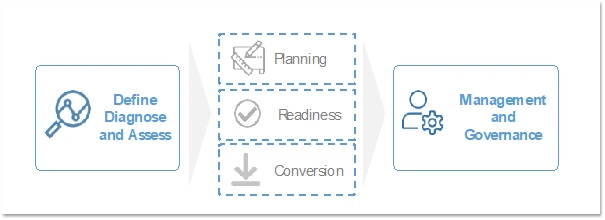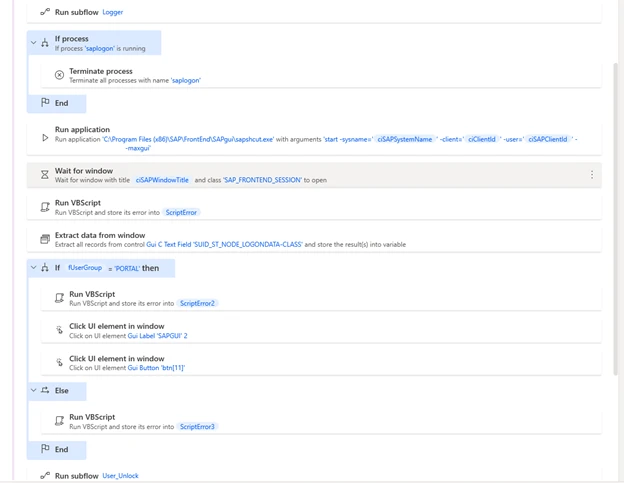Begin your Robotic Process Automation modernization journey
Most legacy RPA solutions are siloed and difficult to maintain and scale as your business grows. This article helps Automation leads within any organization learn how they can efficiently migrate their existing RPA solutions to Microsoft Power Automate. It provides a set of guidance, tools, and services (delivered by Microsoft partners) that makes this process predictable and scalable.
Common challenges for automation solutions
There are many challenges that organizations face as they look to scale up their legacy RPA investments. This includes – identifying the processes to automate, selecting the appropriate automation technology, and implementing solutions with an optimal architecture. It is even more challenging if you have limited time to make investment decisions on your RPA platform and prove Return on Investment (ROI).
These challenges may also pose new opportunities such as potential to (1) increase return on CAPEX investments, (2) simplify program management and governance, (3) reduce cost of parallel runs, operations, and training.
Prescriptive approaches for automation solutions
Prescriptive approaches to modernization can allow you to quickly organize your current RPA landscape, evaluate modern RPA technologies to invest in such as Microsoft Power Automate, and migrate to new automations to make smart investment decisions and measure ROI.
Learn how to improve your organization’s effectiveness by migrating to a low-code RPA platform like Microsoft Power Automate. Let’s discuss a methodology that can help you pair the appropriate tools and service for your RPA modernization journey.
Migration can be approached with 2 styles: “As-is” or Hybrid.

“As-is” approach for migration
For the “As-Is” migration approach, use a prebuilt migration tool. Below you will find existing options that you can use to either migrate yourself or hire a partner to migrate for you.
- Softomotive migrator: Process migrator for Softomotive products
- 3rd party extended migrators: ISVs and SIs are using the extensible versions of the Process migrator tool to build custom migrators for 3rd party software for their customers. A key example is available here: Blueprint RPA Migration Assistant. Engage your RPA implementing partner or work with your Microsoft representative to learn more about using this tool.
Using a tool helps you migrate the current processes “as-is” to the new platform using Power Automate as a desktop automation tool. In the “as-is” approach, you want to prioritize processes that are simpler with predictable results and a clearly defined set of actions. This is a recommended approach to build several desktop-based automations quickly. This approach is also very useful where the processes from the legacy platform are going to run similarly in Power Automate as well.
Hybrid approach for migration
For the hybrid approach, you can consider re-designing, re-engineering, re-architecting, or retiring some of the legacy processes to leverage the best-fit features of Power Automate. Using the 800+ connectors while integrating existing APIs and databases could increase your ROI significantly. However, for the hybrid approach, you must establish a rationale or justification for retiring some processes either with or without redesigned processes of accomplishing the same outcome from automations needed for your business. A hybrid approach to migration avoids the anti-patterns, but it might result in a longer implementation.
You will find several examples of design patterns that can help you evaluate the best fit approach for your business processes in the RPA migration whitepaper.
Methodology for implementing the migration
After you have selected your approach, begin the migration with the following methodical phases. The migration methodology is the same for both approaches, so let’s read ahead:

First and foremost, begin your migration with clearly defined goals after you diagnose your current RPA landscape, and assess the dependencies of various integrated systems that will be affected. From here, you should have a solid understanding of your current RPA landscape, an inventory of your current processes, and which approach you intend to use for the processes. Additionally, introduce an unbiased entity such as a certified System Integration partner to provide an objective perspective in how to modernize processes in your RPA landscape.
Second, perform in-depth planning for your migration. You need detailed timelines, allocated resources, and defined responsibilities of who will do what and how it will progress, as well as get evaluated with the appropriate rhythms. The plan must include the current inventory of processes that you prepared earlier. Setup your Power Automate environments, assign roles and responsibilities of the implementation team with appropriate licenses and security roles, and put a training structure in place. If you have a partner helping you with migration, assign the appropriate security roles to them as well by providing them a service administrator equivalent access to Power Automate and the related various integrated systems.
Next, drive readiness for the migration by creating alignment across stakeholders within the organization (IT and Infrastructure, Information Security, Microsoft administrator team, Cloud Operations, etc.). Often, project teams do not gain adequate buy-in from all such stakeholders before they begin. Consider readiness as a key component for automation migrations to activate a strong working project core team.
Before moving forward from Planning & Readiness, check that you have established the essential parts of a successful migration below:
- Identify a core central team that will setup the environments and implement the migration
- Learn the Power Automate environment and governance best practices. Assign Power Platform service administrator role to the core team. This grants users’ the necessary access to Power Automate and other components from the Power Platform
- Establish your tenant and environment strategy. Exclusively provide access only to admins to create net-new and/or production environments and automate the process of requesting new environments through ALM tools in your organization
These best practices are explained in depth in the Automation Kit. The Automation Kit today provides guidance for measuring ROI for newly built Power Automate flows. However, we are planning for a new Migration module that will be built from our experiences from our customer migration engagements. This migration module can be optionally added to the Automation Kit and will assist you with defining and measuring the ROI of your migrated flows.
The next phase of the migration is the most important phase, Conversion. As a best practice, do not attempt to migrate all the processes at once. Perform a series of migrations so that the implementation team builds confidence and proficiency in the components of Power Platform. This also helps you quickly iterate on your approach and plan, if necessary, and begin tracking ROI.
- Start with simple processes that are Desktop-based automations – as can use the tools discussed above that can predictably migrate processes to Power Automate for Desktop flows
- Move to the processes that can be custom developed using API-based Power Automate for Cloud flows
- Expand to the processes that introduce the AI Builder component
- Next, add approval flows which requires Humans in the loop
- Finally, add custom connectors for homegrown applications
Re-designing your existing process using the hybrid approach will help you optimize the migration to Power Automate and reduce rework at this stage.
Within the conversion phase, conduct code release planning sessions with all stakeholders. For the actual code migration of legacy bots to Power Automate, follow your organization’s BOT SDLC (B/RDLC – Bot/Robotic Development Lifecycle) approach. This must include a system integration test and user acceptance test before moving the sets of code to production.
Finally, set up a sustainable Management and Governance structure with hyper-care and cutover. Hyper-care and cutover are essential to building continuous governance, and structured efforts to manage the new processes in Power Automate. A continuous line of sight and feedback mechanism will help you iteratively apply the best practices and learnings to existing and new Power Automate processes going forward. Some of the key elements to keep in mind are:
- Form the governance team that will manage the Power Automate platform going forward with appropriate approvals and monitoring tools
- Setup Data Loss Prevention (DLP) policies that align to your organizational policies
- Form and socialize Solution and Certification guidelines
- Build and communicate change management guidelines with all teams and stakeholders
- Drive compliance and “Do the Right Things” culture
These best practices are discussed in an organized way in the Automation COE using the Automation Kit.
Wondering how a customer did such a migration?
In 2021, Pacific Gas & Electric (PG&E) embarked on an ambitious Digital Productivity program leveraging automation and citizen development. While PG&E had multiple automation software tools in place, the lack of flexibility and slow adoption by co-workers necessitated a new approach that would enable them to consolidate their toolkit and expand their capabilities for the future. PG&E engaged long-time partner Cognizant and its Intelligent Process Automation team and decided to deploy Microsoft Power Platform.
As the Digital Productivity team planned their implementation, they recognized an opportunity to consolidate their toolkit and migrate existing automations to Power Platform. After evaluating the RPA landscape, they determined that 12 automations spanning Finance, Gas Operations, Customer Care, and Contract Management would need to be migrated to Microsoft Power Platform first. The migration of the bots leveraged Cognizant Neuro® Automation Workbench (AWB) enabling a faster implementation with a reduced team size – migration efforts leveraging Workbench often are reduced by at least 60%.

Eventually, the migration enabled a 100% replacement of their existing RPA platform, resulting in $130k in license savings and enabling PG&E to focus on the consolidated toolkit that they would scale across the enterprise. Eric Soria, Product Owner at PG&E stated
“The migration to Power Platform was crucial in our ability to begin rationalizing our automation tool footprint. We’ve been able to reduce our licensing costs, while simultaneously expanding capabilities and enabling Citizen Development. I look forward to continuing to scale the platform in PG&E, and to bringing digital productivity to more of our co-workers.”
In addition to the migration implementation, which shaped out as a hybrid approach, PG&E has driven year-over-year successful adoption of Power Platform to experience cost-savings and increased productivity. Read their full story here: Pacific Gas and Electric.
Wondering about your modernization journey?
Do not hesitate to begin your RPA modernization journey. Just like PG&E, find your success with cost savings, streamlined program management and governance, increased return on investments.
For a comprehensive list of tools and service offers for RPA migration, check the offers below:
- Use the Process Migrator to migrate from Softomotive to Power Automate
- Leverage the Blueprint Software Systems’ RPA Bot Migration Assistant to migrate to Power Automate
- Leverage Cognizant’s RPA Bot Migrator tool and service to migrate from your RPA platform of choice
- Leverage Avanade’s Power Automate Migration 2-Wk Assessment service
- Leverage Hitachi’s Migrate & Modernize with RPA: 4wk Implementation service
Microsoft is also bringing these offers together in an RPA migration program, which will provide a holistic way for you to pilot a migration project with a tool, service, and prescriptive guidance. This is only available for a limited number of customers. Please speak with your Microsoft representative to learn more about it.
Check out this cool video where the Power Automate team discusses RPA migration:
